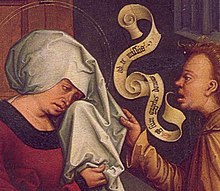Banderole
A banderole (French: [bɑ̃dʁɔl] ⓘ, "little banner") is a comparatively small but long flag, historically used by knights and on ships, and as a heraldic device for representing bishops.
Bannerol, in its main uses is the same as banderole, and is the term especially applied to banners about a yard square carried at the funerals of great men and placed over the tomb.[1][2] Often it commemorated a particular exploit of the person bearing the coat of arms. Banderole (a wooden stick having one pointed end covered with metallic shoe) is used in conventional military survey. It's used to depict various stations established during carrying the survey forward. Double banderole are used to erect Survey Beacon.
Knights, bishops and ships
A banderole is a small flag or streamer carried on the lance of a knight, or a long narrow flag, with cleft end flying from the mast-head of a ship in battle.[1][2]

In heraldry, a banderole is a streamer hanging from beneath the crook of a bishop's crosier and folding over the staff,[1][2] and for other small streamers or ribbons.[3]
Art and architecture

The term is also used in
Notes
- ^ a b c Chisholm 1911, p. 312.
- ^ a b c OED staff 2011.
- ^ Nelson 2010.
- ^ Chisholm 1911.
- ISBN 978-0-271-02091-4
References
- OED staff (September 2011). "banderol[e] | bandrol | bannerol, n.". Oxford English Dictionary (Second 1989; online version September 2011. ed.). Earlier version first published in New English Dictionary, 1885.
- Nelson, Phil (1 February 2010). "Banderole". Dictionary of heraldic terms.
Attribution:
- This article incorporates text from a publication now in the public domain: Chisholm, Hugh, ed. (1911). "Banderole". Encyclopædia Britannica. Vol. 3 (11th ed.). Cambridge University Press. p. 312.
